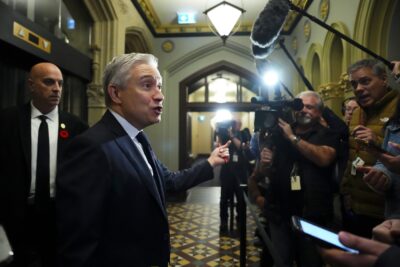Liberal budget earmarks billions for ‘bold and swift action’ to meet U.S. disruption
By Canadian Press on November 4, 2025.

OTTAWA — Prime Minister Mark Carney’s first federal budget takes a big swing at making Canada’s economy a more attractive place to invest with billions of dollars for infrastructure and new tax opportunities for business.
Finance Minister François-Philippe Champagne tabled the long-anticipated budget in the House of Commons on Tuesday afternoon. In prepared remarks, he said that it’s time for “bold and swift action” to build Canada’s economy for an uncertain future.
“There is no place for withdrawal, ambiguity or even standing still,” Champagne said in his speech.
The 406-page budget — the title of which repurposes Carney’s election slogan “Canada Strong” — includes almost $90 billion in net new spending items over five years. Most of the spending is aimed at bolstering Canada’s economy and securing its sovereignty in response to U.S. President Donald Trump’s protectionist policies.
TD Bank senior economist Francis Fong said Budget 2025 marks a departure from Liberal spending plans of the past, which would typically offer an array of smaller spending measures spread across various industries and demographics.
“It should be very clear to Canadians that Prime Minister Carney is really just focusing on competitiveness and trade. And I think that’s a very positive thing,” Fong said.
The budget’s new spending is aimed squarely at boosting productivity and funding cross-country infrastructure projects that would help businesses reach new markets and reduce their reliance on the United States.
That includes $5 billion over seven years for a national trade diversification corridor and $1 billion over four years for Arctic infrastructure.
Budget 2025 also adopts a measure not yet in legislation from the Liberals’ fall economic statement last year — to allow businesses to write off the full tax costs of some machinery and technology upfront, freeing up cash flow.
That measure — one of a series of moves designed to attract business investment to Canada — pushes back against Trump’s One Big Beautiful Bill Act, a landmark piece of U.S. legislation attempting to lure more businesses to relocate south of the border.
Champagne told reporters at a press conference prior to the public release of the budget Tuesday that Canada is the “most competitive jurisdiction” in the G7 for investment, based on the country’s low marginal effective tax rate — how much tax is applied per dollar of business investment.
What remains to be seen, Fong said, is whether those businesses will bring their money to Canada, and whether domestic firms can take advantage of new national infrastructure to reach global markets like Europe and Asia.
Fong said Carney is “swinging for the fences” with this budget, but the plan itself lacks details on tax and regulatory reform.
“The real question is, if we build it, will they come? And there wasn’t a lot of detail in this budget in terms of how are we actually going to incentivize the firms to make those investments to take action and diversify trade,” he said.
Most major spending items in this budget — billions for defence and a one-percentage-point income tax cut delivered in July — were already telegraphed ahead of time, leaving few surprises in the document itself, Fong noted.
Budget 2025 adds $89.7 billion in net new spending over five years. That figure incorporates a projected $51.2 billion in savings over the same horizon from departments’ budget cuts and various government efficiency measures.
The budget projects a deficit of $78.3 billion for this fiscal year — more than double estimates for last year and roughly in line with a broad range of analysts’ estimates heading into Tuesday.
The debt-to-GDP ratio, previously a fiscal anchor for the federal government, is expected to rise modestly and then stabilize over the coming years.
The Liberals’ forecast meets the party’s new stated goals of a declining deficit-to-GDP ratio and a balanced operating budget in three years.
Some fiscal critics, including interim Parliamentary Budget Officer Jason Jacques, raised alarm bells before the budget was tabled about Canada’s fiscal sustainability and the expected pace of spending and borrowing.
The Conservatives urged the Liberals to cap the deficit at $42 billion this year and accused the government of “reckless” spending.
Champagne defended the decision not to balance the budget in his speech Tuesday. He argued slashing the deficit would result in cuts to vital social programs and a failure to make the capital investments needed to pivot Canada’s economy.
Randall Bartlett, deputy chief economist at Desjardins, said Budget 2025 is “a step in the right direction” but he doesn’t feel the spending plan meets the ambitions cited by Carney and Champagne ahead of its release.
“I think they need to stretch a bit further in terms of providing greater tax advantage to investment,” he said.
Efforts to save money across the public service are also lacking, Bartlett said, because they rely on re-indexing pension benefits rather than the hard work of actually making government smaller.
The Liberals also presented upside and downside scenarios in this budget that depend on whether economic growth comes in stronger than the relatively weak baseline underpinning its fiscal outlook.
A stronger-than-expected economy would help to shrink the deficit by an extra $5 billion each year, according to budget projections — which would help to get debt-to-GDP on a declining path in a shorter period of time. In the downside scenario, economic weakness would deepen the deficit by $9.2 billion annually.
Bartlett said he sees “substantial risk to long-term fiscal sustainability” if the economic forecast comes in on the lower side of the government’s projections.
Rachel Samson, vice-president of research at the Institute for Research on Public Policy, said the Liberals are “cutting it fairly close” on their fiscal anchor of a declining deficit-to-GDP ratio.
While she said she isn’t overly concerned with the government’s fiscal sustainability, she agrees with Bartlett that a worsening economic outcome could mean the government misses key fiscal anchors.
This report by The Canadian Press was first published Nov. 4, 2025.
Craig Lord, The Canadian Press
-34

